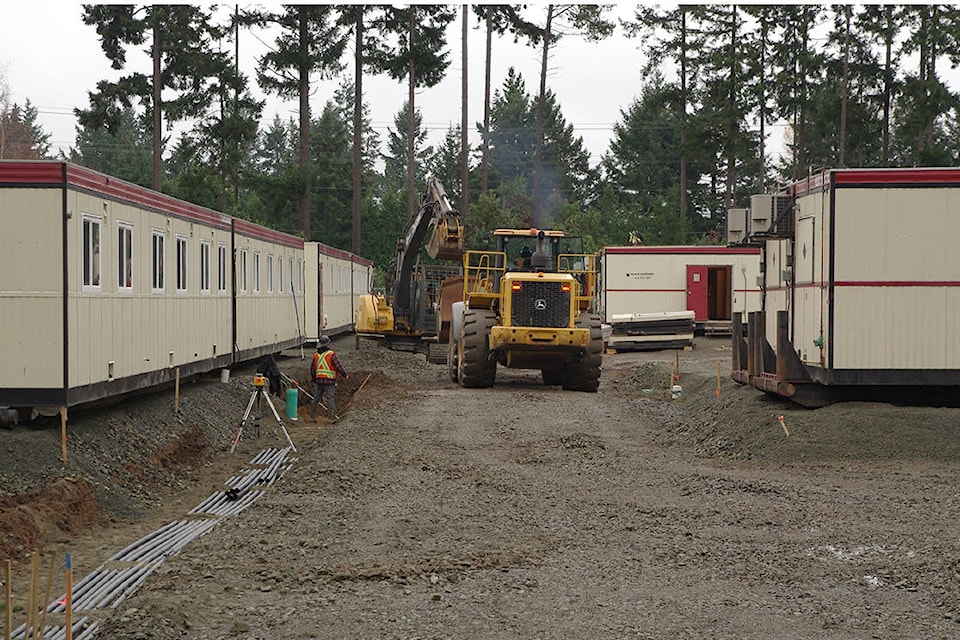It’s in Nanaimo’s best interests that two new supportive housing projects succeed, say service providers.
With temporary supportive projects set to open at Terminal Avenue and Labieux Road by the end of the month, B.C. Housing held a live-streamed online question-and-answer forum Thursday night.
“This is about people’s homes,” said Dominic Flanagan, executive director of B.C. Housing. “This is about people who are homeless coming inside and having that opportunity and that sense of hope and dignity back in their lives.”
The Terminal Avenue project will have about 80 units; the Labieux project, about 90. Rent is $375 per month and meals and services will be at the sites, which will be staffed 24 hours a day, seven days a week. There are no curfews, but residents must sign ‘program agreements’ and take some responsibility for their guests.
“There will be councillors available, support staff available to help hook them up with mental health services if that’s necessary, health services, which is a huge need, and further, to start work on integrating them back into and welcome into the community, whether it be through work programs, volunteer programs, other activities like that,” said Dean Fortin, executive director of Pacifica Housing, operator of the Labieux site.
A goal is to build a therapeutic community, said Violet Hayes, executive director of Island Crisis Care Society which will operate the Terminal site.
“And then we see that the people really have that belief in themselves that they can move forward and grow,” she said.
Flanagan said there’s a “really urgent need” in Nanaimo and Heidi Hartman, B.C. Housing’s regional director for Vancouver Island, said with tent city closing Nov. 30, the city’s “most vulnerable” need to be housed.
Members of the public participating in the Q-and-A asked about a range of topics, such as why the Labieux Road site was selected considering its proximity to Beban Park.
Dale Lindsay, City of Nanaimo director of community development, said the Labieux public works yard was identified because it’s a piece of city land that can be spared in the short-term. He suggested there would have been an impact on parks no matter what.
“Our parks were already under a significant amount of strain from people living in the parks throughout the community. What was maybe a downtown issue a few years ago has really become an issue that covers our entire community right now,” Lindsay said. “The city wanted to make sure that we didn’t end up in a situation where we were basically pushing people out of tent city back into … social disorder problems in our parks system.”
Asked what “temporary” means in relation to the Labieux site, both Fortin and Lindsay mentioned two-to-five years as a timeline.
“Part of the answer of ‘how long’ is in the answer of, well, how long will it take us to identify sites and work with the community,” said Lindsay. “And then the recognition beyond that that once sites are identified and they’ve gone through their process, there’s still that time to build those developments out and go through that permitting process.”
Hartman said the supportive housing projects are meant to provide stability for people who haven’t had that because of various challenges they’ve faced.
“The goal will be to stabilize folks, to connect them to resources and ensure that [they are] staying in housing or moving into market housing with rent supplements,” she said.
Lisa Murphy, who works in mental health and substance use services at Island Health, said the housing can help people overcome addictions.
“People in a safe, supportive environment are often at a good opportunity to look at the things that are causing them challenges, substances being one of them…” she said. “It’s very difficult to consistently offer substance use recovery services to someone who’s homeless. Hard to find them, hard to reach out, hard to have the consistency and structure that really supports people.”
story continues below
The first two supportive housing units are being hoisted into position at Terminal Ave. and Bryden St. #supportivehousing #Nanaimo @NanaimoBulletin pic.twitter.com/iiSSuAHpRN
— Chris Bush (@ChrisBushphotog) November 23, 2018
Asked about impacts on neighbouring real estate values, Flanagan said B.C. Housing has looked not only at B.C. Assessment statistics, but also a range of other data that shows no impact on property values.
A few members of the public asked about safety and security, and those concerns will be continually discussed and addressed, said operators. Fortin said it’s important to remember that the residents coming to live at the housing are committing to try to make it work and Flanagan said in the area of Pacifica’s Uplands Walk project in north Nanaimo, crime has not increased.
“I hope we haven’t painted this to be too rosy, because we think we’ve thought of everything, but … I want people to know that this is a dialogue that continues,” Fortin said.
Hayes said temporary supportive housing is not the whole solution in Nanaimo, but it is a good start.
“We have this wonderful opportunity to be successful in changing lives,” she said. “I know some people have some really strong opinions that what we’re doing is not right, that we’re condoning … and I just want to say that we have the best interest of the people that we’re serving and we really want to see them succeed, so that’s why we’re doing what we do and I hope we’ll have a lot of community support to do that.”
Community dialogue sessions are scheduled for Nov. 27-29; residents can learn the locations of the meetings after registering at www.LetsTalkHousingBC.ca.
RELATED: B.C. Housing working to meet timelines on temporary supportive housing in Nanaimo
editor@nanaimobulletin.com
Like us on Facebook and follow us on Twitter
